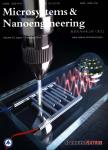MEMS inductor fabrication and emerging applications in power electronics and neurotechnologies
作者机构:The Rowland Institute at HarvardHarvard UniversityCambridgeMAUSA Department of Mechanical EngineeringTechnical University of DenmarkLyngbyDenmark Department of Electrical EngineeringTechnical University of DenmarkLyngbyDenmark Department of NeurosurgeryMassachusetts General HospitalHarvard Medical SchoolBostonMAUSA Boston VA Healthcare SystemBostonMAUSA Key Laboratory of 3D Micro/Nano Fabrication and Characterization of Zhejiang ProvinceSchool of EngineeringWestlake UniversityHangzhouChina Institute of Advanced TechnologyWestlake Institute for Advanced StudyHangzhouChina
出 版 物:《Microsystems & Nanoengineering》 (微系统与纳米工程(英文))
年 卷 期:2021年第7卷第4期
页 面:1-22页
核心收录:
学科分类:080805[工学-电工理论与新技术] 0808[工学-电气工程] 0809[工学-电子科学与技术(可授工学、理学学位)] 08[工学] 0817[工学-化学工程与技术] 080202[工学-机械电子工程] 0807[工学-动力工程及工程热物理] 080401[工学-精密仪器及机械] 0804[工学-仪器科学与技术] 0805[工学-材料科学与工程(可授工学、理学学位)] 0802[工学-机械工程] 0811[工学-控制科学与工程] 0702[理学-物理学]
基 金:supported by the Lundbeck Foundation,grant R305-2018-2779 the Novo Nordisk Foundation,grant NNF0064289 A.H.acknowledges the support from the Marie and B.Richters Foundation.R.l.H.acknowledges that the research leading to these results received funding from the European Union’s Horizon 2020 research and innovation program under the Marie Sklodowska-Curie grant agreement no.754462(EuroTechPostdoc) sponsored by the NIH NEI R01-EY029022(to S.W.L.) by the BRAIN Initiative NINDS U01-NS099700 and the Dept,of Defense/CDMRP(VR170089)(to S.I.F).D.Z.and M.Q.acknowledge the support from the National Natural Science Foundation of China(61927820)
主 题:inductor power lithography
摘 要:MEMS inductors are used in a wide range of applications in micro-and nanotechnology,including RF MEMS,sensors,power electronics,and *** technologies set the boundary conditions for inductor design and their electrical and mechanical *** review provides a comprehensive overview of state-of-the-art MEMS technologies for inductor fabrication,presents recent advances in 3D additive fabrication technologies,and discusses the challenges and opportunities of MEMS inductors for two emerging applications,namely,integrated power electronics and *** the four top-down MEMS fabrication approaches,3D surface micromachining and through-substrate-via(TSV)fabrication technology have been intensively studied to fabricate 3D inductors such as solenoid and toroid in-substrate TSV *** 3D inductors are preferred for their high-quality factor,high power density,and low parasitic capacitance,in-substrate TSV inductors offer an additional unique advantage for 3D system integration and efficient thermal *** features make in-substrate TSV inductors promising to achieve the ultimate goal of monolithically integrated power *** another perspective,3D bottom-up additive techniques such as ice lithography have great potential for fabricating inductors with geometries and specifications that are very challenging to achieve with established MEMS ***,we discuss inspiring and emerging research opportunities for MEMS inductors.



